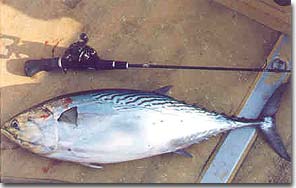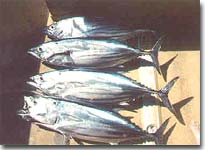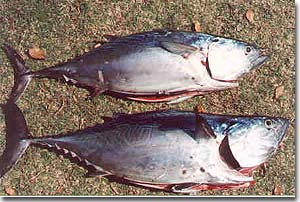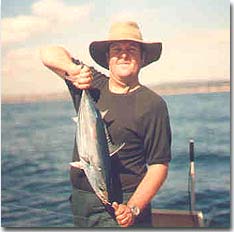Sportfishing For Tuna
Sportfishing For Tuna
The most common species of tuna are Striped Tuna , Bonito , Frigate Mackerel & my favorite Mackerel Tuna. Striped tuna are also known as skipjack tuna. I am just going to cover light tackle methods I use for tuna fishing & mainly lure casting as opposed to trolling. Tuna fishing is a top method of fishing & is a lot of fun.
 Tackle
Tackle
In fly tackle I normally use my Loomis IMX 10 weight with a Systems 2 10/11 reel. Line choice is a Teeny Nymph weight forward intermediate line in 10 weight. I am aware a ten weight outfit is a bit of overkill on striped tuna but it handles mackerel tuna well & as I like to think positive I'm always hoping to hit a small Yellowfin tuna mixed up in a school of smaller tuna. I have pulled a couple of 20 kilo Yellowfin tuna out of striped tuna schools on 10 kilo spinning tackle in the past so I live in hope. Just about any small baitfish pattern fly will work on these fish. I have found the tail of a tuna will wear through soft leader material very quickly & I now use a long shock leader of 10kg line & check it very regularly for wear.
In conventional tackle I prefer to use baitcasting tackle however good quality threadline gear is fine. The reel I am currently using for my 3kg baitcaster is a Daiwa PT33 SH with a 7:1 gear ratio. The speed gets a lot of strikes but its hard work with that ratio when a fish is on, still it is better to hook a fish & complain than not hook one at all. The reel I use for 4kg line is a Shimano Curado CU 200B with a 6.2:1 gear ratio. In Threadline tackle when using 2 & 3 kg line for frigate mackerel & bonito I use a Shimano Stradic ST4000 with a 6.2 : 1 gear ratio. In rods there are many on the market that will fit the bill for this type of work but I strongly recommend looking at the Shimano / Steve Starling rods or the new series called the Millenium series. If it sounds like I am pushing Shimano tackle you are correct. I have several Shimano reels & rods & have had years of excellent service from all of them. I still use one of the original Shimano Speedmasters for light trolling & casting & it is still going strong.
 Lines are a thing of personal choice here. The new super lines are great for this type of fishing especially if you have done a bit before. If you are just starting off I would recommend sticking to normal mono as it is a bit more forgiving of little mistakes the stretch will let you get away with it. I use Berkley Fireline in the fluorescent green colour in 2,3, & 4 kg breaking strains & am very happy with it. I have heard great things about Spiderwire as well so like I said its personal choice. In standard mono I would recommend Platypus Platinum in the same breaking strains. I use a tough leader when I am lure fishing & for years have used 8 &10kg Tortue for this. I suppose one day I will go to braid for this also but old habits die hard. One word though, check your knots especially in the braided lines if one slips its all over. One final word on tackle. Every item of your tackle needs to be in 100% tip top condition. Bail rollers MUST roll all the time freely. Drags MUST be smooth as silk , all guides must be in good condition as tuna will rapidly find faults in poorly maintained tackle. On lines you need a full spool & an unbroken length of quality line. I do not think the " top shot" method of topping up the spool has any place here. Tuna will regularly show you the bottom half of your line load on this tackle & I do not think it wise to have a joining knot between me & a fish on a regular basis.
Lines are a thing of personal choice here. The new super lines are great for this type of fishing especially if you have done a bit before. If you are just starting off I would recommend sticking to normal mono as it is a bit more forgiving of little mistakes the stretch will let you get away with it. I use Berkley Fireline in the fluorescent green colour in 2,3, & 4 kg breaking strains & am very happy with it. I have heard great things about Spiderwire as well so like I said its personal choice. In standard mono I would recommend Platypus Platinum in the same breaking strains. I use a tough leader when I am lure fishing & for years have used 8 &10kg Tortue for this. I suppose one day I will go to braid for this also but old habits die hard. One word though, check your knots especially in the braided lines if one slips its all over. One final word on tackle. Every item of your tackle needs to be in 100% tip top condition. Bail rollers MUST roll all the time freely. Drags MUST be smooth as silk , all guides must be in good condition as tuna will rapidly find faults in poorly maintained tackle. On lines you need a full spool & an unbroken length of quality line. I do not think the " top shot" method of topping up the spool has any place here. Tuna will regularly show you the bottom half of your line load on this tackle & I do not think it wise to have a joining knot between me & a fish on a regular basis.
Rigs
Rigs for this type of tuna fishing are reasonably simple. On conventional tackle I use approx 3 meters of double line tied to a shock leader of 8 or 10kg line of approx 1 meter in length. I use the Bimini Twist for my double knots & the Albright not to fasten my double to the leader. I will put an illustration of the Albright & Bimini Twist (thanks Pete) on a separate page. Click this link KNOTS to view it. With fly tackle it is just a conventional leader with a tippet of your choice but I use a long shock leader.
Lures
There are many, many lures of many different brands that will do the job & catch tuna. I will name a couple of my favorites along with the brands but there are so many different types & manufacturers on the market now that I have only personally tried a few. We are looking for small slug or baitfish lures that are compact & cast well. A couple of my favorites are from Nat Nat Lures & they are Bill's Slug in 10 & 15 gram models & Halco Twisty in 5 ,10 & 15 gram models. I have had a lot of success with these but the choices on today's market are many. Make sure they are fitted with strong rings & trebles.
 Methods
Methods
When you have found a working school of tuna it is very important to watch how they are feeding. A sure indication they are feeding on tiny bait like glass minnows , krill , or tiny whitebait is when they are traveling very rapidly & just shooting across the surface with their mouths open. Normally there are a few fish shoulder to shoulder doing this. Generally on days like this you will have a lot of casts do a lot of boat maneuvering & catch very little. Tuna get very single minded about what they will eat on these days. You will need to check the direction they are feeding in & generally they will feed into the wind. Position the boat well in front of the tuna school & off to one side. This will allow you a couple of shots as the fish pass you. You must cast in front of the fish they cannot see lures behind them & generally the fish you will get a strike from have broached the surface & are on the way down again. These tuna can be 10 to 15 meters in front of what you see happening on the surface. So you need to allow time for the lure to travel through the air & for the retrieve to begin. Always allow too much ahead rather than not enough. If the tuna are breaking over a large area with a lot of surface chops rather than skimming & not moving about much it generally means they are feeding on larger bait such as pilchards or large whitebait. This is the type of day we hope for. Again position the boat near the schools of tuna & in casting range & work along the edges of the schools. A point I will make in positioning the boat for both types of feeding is it is preferable to cast across the wind or even upwind as the boat drift will increase the lures speed & tuna like it fast. Casting downwind is easier but as the boat is drifting toward the lure its speed is reduced & so will be the number of strikes. If you are getting regular follows but no strikes a method I have been using the last couple of years is to smear my lure or fly with some Halco Catch Scent it seems to often induce a strike on these days. Worth a try anyway. Fast retrieves are the way to go & on fly gear I normally put the rod between my legs & strip line with both hands. I must say of late I have been experimenting with a dead slow retrieve & it has worked pretty well. If you are not getting regular strikes try different retrieves & lures as these fish can be fussy. An old trick which works particularly well on Bonito is start off retrieving flat out for about 10 meters then stop it dead for a second or two then start winding at a medium retrieve. You will often get hit as soon as the lure starts moving again.
 The Fight
The Fight
No matter what tackle you use or what type or size of tuna you hook NONE of them come easy. Tuna go hard & long & fight to the last. There are a couple of things that will happen after the hook-up. Generally the tuna will shake its head about a bit for a few seconds then its away on a long fast run. If your drag is not perfect this is when it will tell with a broken line & a lost fish. When the tuna runs he will go long & hard & you need to be aware that as spool diameter decreases drag increases & water pressure on the line builds up. You MUST start backing off the drag as the line goes out. How much is a difficult amount to write. As a rule of thumb try to keep the load on the rod the same both in feel & by looking at the bend. It's something you will learn by experience. Try to get the boat after the fish to reduce the amount of line out. After a run the fish normally go deep & begin to circle. All you can do is work on them to get them back up. A couple of points to remember is to keep your pumping steady & rhythmical. Watch the line where it meets the surface you will see it cutting a small circle in the water. Watch this & as the line passes 12 o'clock position & starts coming towards you work hard for line the fish at first when he circles away will take the line back but at least he is working for it. Try to position the boat down wind of the fish. This does 2 things, firstly the boat wont drift over the line & secondly it will help plane the fish back to the surface. It will take time to land the fish but after all that's what its all about. When the fish is close to boat it is time for patience & a cool head this is when most fish are lost. You need to remember the fish is still capable of a last minute charge so be ready. It can be frustrating to have a big striped tuna or mackerel tuna circling ten feet away for 5 minutes but just keep the pressure on he will come up. To take your fish I prefer a small gaff to a net . Nets are too hard to move quickly in the water but again its a personal thing. This is not the time for gaffing practice so if in doubt use a large net & the fish is yours. Good Luck!
Comments
I would like to make a couple of points here. The first is that this is NOT tag & release fishing. The fish are too far gone after a fight on this type of tackle to release. Most of them & I would say 95% would not recover & would die. Keep them for bait & berley as they are all excellent for this. I often use Mackerel Tuna for sashimi & am very partial to a fillet of grilled Bonito as well . If you want to tag little tuna use 10 kilo gear do it quick & have a ball. I do this often. The second point is that this type of fishing is often overlooked by anglers. I love it. The fish are readily available to all & tackle does not cost a million bucks. Give the little tunas a go its a great way to go!
Ken Alexander
|